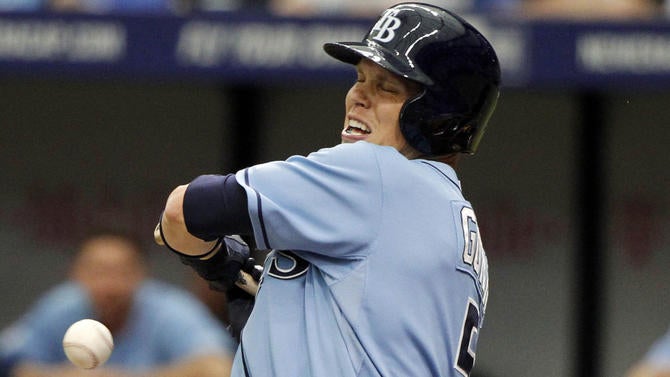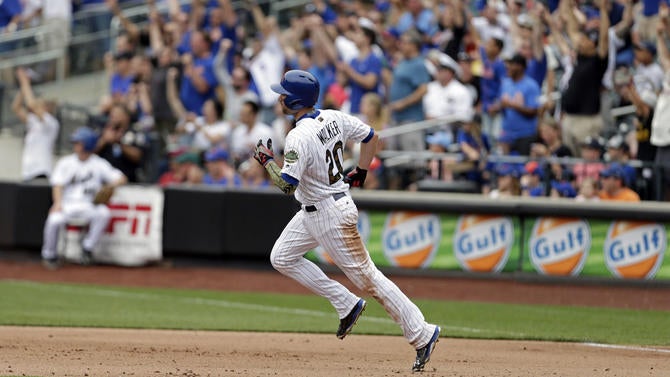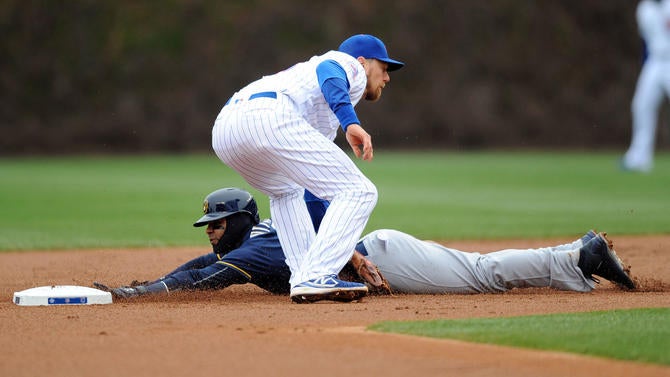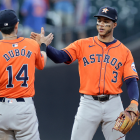The calendar has flipped to June, which means we need to start taking this season's numbers more seriously. Look around the MLB landscape, though, and you'll find a bunch of stat lines that seem to make no sense. All around the league, there are players crushing their career norms, or even taking aim at all-time records.
We found four stat lines that qualify as really weird, incredibly impressive ... or both!
Clayton Kershaw is not of this Earth

My favorite moment of the 2016 season happened on May 12. That night, the Dodgers were playing the Mets. After setting down the first two batters of the first inning, Clayton Kershaw ran the count full against David Wright. On the 3-2 pitch, Kershaw tried to nip the inside corner, but missed by a couple of inches, giving Wright a free pass to first base.
A two-out walk against a patient hitter in the first inning of a random May game would be considered routine for just about any pitcher on the planet. Not for Kershaw. He turned away from the mound and yelled into his glove, absolutely furious with himself for allowing a baserunner.
What made Kershaw's frustration doubly hilarious is how harmless that walk proved to be. The Dodgers ace followed that up by striking out Yoenis Cespedes to end the inning. The Wright walk would prove to be one of just four baserunners the Mets mustered all day, as Kershaw fired a 13-strikeout, three-hit shutout, plowing through a potent lineup in a blazing-fast, two-hour, 13-minute affair.
Walks have become something like a solar eclipse for Kershaw this season. That base on balls allowed to Wright was one of just five free passes that Kershaw has issued in 11 starts this season, covering 86 2/3 innings. Meanwhile, he's struck out an incredible 105 batters, netting a 21-to-1 strikeout-to-walk rate that would be the best in baseball history (by far) for any ERA title-qualified starting pitcher if he can maintain it over a full season.
The walks record will be a tougher one to capture. In 2005, Twins right-hander Carlos Silva walked just nine batters all season; even though he made a comparably modest 27 starts with 188 2/3 innings pitched, that's still an incredible effort, the best by any qualified starting pitcher in the past 100 years. Still, Kershaw's got a fighting chance to approach that record, if he can simply walk no more than one batter a month.
Before you declare that to be impossible, consider that Kershaw just completed a month of May in which he struck out 65 batters, and walked two. Kershaw walks have become so rare that fans (of other teams!) are now evaluating each of those miscues with Zapruder film-like scrutiny, lamenting the injustice of every missed umpire's call. So the next time Kershaw barely misses his spot, or gets jobbed by an ump, now we can all gnash our teeth in agony, lamenting that the greatest pitcher on the planet is only perfect most of the time.
Brandon Guyer is on the Hunt

There's a reason getting hit by pitch is known in baseball circles as "taking one for the team." No matter where on your body you get plunked by a 95-mph fastball, it's going to hurt. In many cases, it's going to hurt for days, and it's going to leave a big, ugly welt too. So while getting hit by a pitch earns the batter a free trip to first base, few are willing to sacrifice their bodies regularly by leaning into pitches and absorbing the blow.
Ron Hunt was a rare exception. A little second baseman in the 60s and 70s, Hunt lasted 12 years in the big leagues thanks mostly to his willingness to do anything to get on base, and to help his team win. He'll happily recount the time he goaded Bob Gibson into plunking him, followed by Hunt flipping the ball back to the most intimidating pitcher in the game after it rolled to a stop. Though it's not quite as unbreakable a record as Cy Young's 511 wins or Joe DiMaggio's 56-game hitting streak, Hunt's record of 50 times hit by a pitch in 1971 could last for decades to come.
Or it might, if Brandon Guyer stops becoming human target practice. A fifth-round pick by the Cubs in the 2007 draft, Guyer was long considered a spare outfielder type, both in Chicago and after coming over to the Rays in the Matt Garza-Chris Archer blockbuster of 2011. Then last season, Guyer saw a career-high 385 plate appearances, faring well in his first exposure to a role beyond fill-in and short side of a platoon. He batted .265/.359/.413 last season over 128 games; adjust for Tropicana Field's pitcher-friendly environment, and that line was 21 percent better than league average. How did Guyer get on base so frequently, given that decent but not great batting average, and a poor 6.5 percent walk rate? Getting hit a league-high 24 times sure helped.
Guyer is now threatening to obliterate last year's HBP output, and maybe make a run at Hunt's mark too. Thanks to a spate of injuries, Guyer has taken over regular playing time in the Rays outfield. And he's making the most of that opportunity, batting an impressive .299/.392/.528, numbers that grade out as 58 percent better than league average -- seventh-best in the American League for any hitter with as many plate appearances.
While Guyer's hitting the ball hard more frequently and hitting for more power, a hit-by-pitch barrage has fueled that lofty on-base percentage. Guyer's 14 HBPs in 149 plate appearances easily lead the majors. Moreover, Guyer's HBP pace nets out to 56 in 600 PA; if he were to hang onto regular playing time when Kevin Kiermaier returns to the lineup, the hunt for baseball history could be on.
Neil Walker might have figured out the right approach

When Daniel Murphy filed for free agency at the end of last season, the Mets knew they had to find an able replacement, ideally someone who could offer similar offensive production. And while few players in all of baseball can match Murphy's 2016 onslaught with the Nationals, the Mets still did pretty well for themselves. Because not only is Walker raking -- he's hitting shockingly well from the right side of the plate.
In the first seven seasons of his career, the switch-hitting Walker batted a measly .260/.318/.339 against left-handed pitchers, with just six home runs in 801 plate appearances. This year, he's gone bonkers against lefties. In 43 plate appearances against southpaws, he's batted an off-the-charts .325/.372/.750; in 43 plate appearances, he's already crushed five long balls against them.
How has he done it? Former major leaguer/current VICE Sports writer Fernando Perez interviewed Walker last month, asking him about the second baseman's approach from each side of the plate. Walker said he takes a simpler approach from the right side, with a straight leg kick instead of the toe-tap timing mechanism he uses from the left side. It's a great interview well worth checking out (Perez was one of the smartest, most thoughtful players in the game during his playing days, and offers strong insight here too), but doesn't necessarily answer the question of what's specifically changed for Walker in 2016.
So feel free to speculate on what it might be. Maybe Walker's finally figured things out from the right side thanks to years of experience. Sure, this could be just a function of a small-sample fluke, one that's bound to level off before long. Or maybe the Pittsburgh native's just a really good ballplayer who's simply figured it out.
Whatever the case, the Mets have their starting catcher, first baseman, and third baseman on the shelf, and must contend with a formidable opponent in the Nationals. They'll take all the help they can get...from both sides.
Jonathan Villar suddenly looks like Kenny Lofton

Jonathan Villar has always been fast. He had seasons of 45, 34, 39, 31, and 35 steals in the minor leagues. Coming into this year, he'd swiped 42 bases in just 658 career plate appearances -- roughly the equivalent of one full season. Villar never showed much power, and even at his best was merely an adequate on-base threat, making him a nice asset as a utility infielder, but seemingly not much more.
In a rebuilding season, the Brewers figured they could try to use him a little more. With top prospect Orlando Arcia developing in the minors, maybe Villar could serve as a decent stopgap, someone who could help the team stay semi-competitive until Arcia and other kids make it to the Show.
Instead, Villar's been one of the biggest surprises in baseball this year. On Tuesday night, Villar went 1 for 3 with a walk and a stolen base. That marked the 45th time Villar has reached base this year in 50 games played, reaching base multiple times in 27 different games. Villar's .308 batting average ranks 16th among all qualified National League hitters, while his sparkling .412 on-base percentage ranks ninth. Funny thing about a lightning-fast baserunner who suddenly gets on base: He's going to steal a ton of bases, as Villar has done with an MLB-leading 19 steals this year.
There are reasons to believe this can continue too, when you look at Villar's underlying skills this season. He's swinging and missing less often than ever before, and swinging far less often at pitches out of the zone. He's also hitting more line drives and making more hard contact. There might be a bit of Occam's Razor in play here too. Baseball players often peak in their mid-20s. When the Astros flipped Villar to Milwaukee for then-Single-A right-hander Cy Snead, they were giving up on a player who was headed toward his 25th birthday.
A young, speedy, hyper-aggressive player is finally getting a chance to play everyday...and he's looked pretty damn great doing it.


















